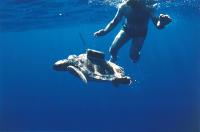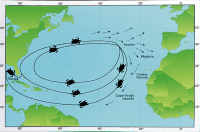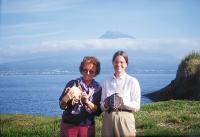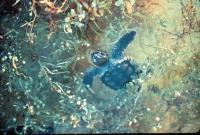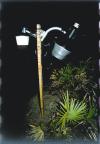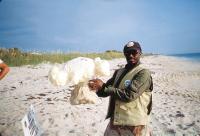|
Archie Carr with green turtle at Tortuguero, Costa Rica. photo by JeanneA. Mortimer |
''Lost Years'' Found
Modern Technology helps track the elusive sea turtle
by Joseph Kays
When Archie Carr began studying sea turtles in the 1940s, his most valuable research tool was personal observation. Nearly half a century later when he died, technology had barely advanced beyond metal tags laboriously attached to turtle flippers.
Today, a decade after Carr's death, his protégés employ everything from DNA analyses to satellite telemetry to help answer questions about which Carr could only speculate.
It is a testament to Carr's knowledge of sea turtles that most of what he hypothesized, modern science has proven to be true.
``I worked with Archie for years before his death, so there is great personal satisfaction in proving his theories,'' says Karen Bjorndal, director of UF's Archie Carr Center for Sea Turtle Research. ``And there is just the thrill of solving the puzzle.''
But the puzzle is far from complete.
In fact, the loggerhead turtle is the only one of the seven species of sea turtle for which scientists have a clear picture of its complete life cycle. For the rest, much of their lives remain a mystery.
``The lost years are still lost for all other species,'' Bjorndal laments, referring to the time between when hatchlings enter the surf of their nesting beaches until they return to coastal foraging areas as juveniles.
|
Juvenile loggerhead just released in the waters around the Azores with a satellite transmitter attached. photo by Ricardo Santos
Hypothesized routes of travel in the Atlantic Ocean for post-hatchling loggerhead turtles. All segments of the journey have been confirmed with tag returns. Illustration by Laurie Walz
Karen Bjorndal with colleague Helen Martins from the University of the Azores holding pelagic-stage loggerheads. photo by Alan B. Bolten
Loggerhead hatchling in a mat of sargassum algae. photo by David Anthony
Experimental lighting array used at Melbourne Beach, Florida. photo by Blair E. Witherington
Alan Bolten and Helen Martins with a loggerhead fitted with a satellite transmitter and ready for release in the Azores. photo by Karen A. Bjorndal
Karen Bjorndal, with green turtle in the southern Bahamas. photo by Alan B. Bolten
Ray Carthy holding a foam cast of a loggerhead nest on Melbourne Beach, Florida. photo by Steve Johnson
Sarah Bouchard working on the nesting beach at Melbourne Beach, Florida. photo by Daniel Wood |
Tracking The Loggerhead
The southeastern coast of the United States represents one of the largest nesting areas for loggerhead sea turtles in the world. Each year, female loggerheads lumber ashore and lay their eggs in some 50,000 to 70,000 clutches from Florida to the Carolinas.
After they emerge from their eggs, the hatchlings make a mad dash for the sea, trying to outrun predators like crabs and birds.
But once the silver-dollar-sized hatchlings enter the ocean, they are not seen again in the western Atlantic until years later, when they reappear in coastal foraging areas as juveniles about 20 inches in diameter.
It took Carr almost three decades to develop his hypothesis that the little loggerheads spent their ``lost years'' in the miles-long rafts of sargassum weed that congregate at the borders of the offshore currents, surviving on jellyfish and other small sea creatures.
Shortly before his death in 1987, Carr felt he had enough information to hypothesize in a published paper that the loggerheads actually rode the currents in a great trans-Atlantic loop, east to the Azores and Medeira and then back to Florida and the Caribbean.
Ten years after that seminal paper, Bjorndal and her colleagues have been able to prove their mentor's hypothesis and further clarify the life cycle of the loggerhead.
Although there was considerable circumstantial evidence to support Carr's theory that loggerheads from the Southeastern United States were migrating to the eastern Atlantic and Mediterranean, there was little hard proof until the emergence of new DNA analyses in the late 1980s.
``This is a classic example of a question we've been able to revisit and improve our ability to answer as technology has advanced,'' Bjorndal says.
Brian Bowen, a scientist at UF's Biotechnologies for the Ecological, Evolutionary and Conservation Sciences (BEECS) laboratory, was studying DNA in the blood of loggerhead sea turtles when he discovered that turtles born on different nesting beaches could be distinguished by their DNA sequence patterns.
Using just a few drops of blood and a research technique known as Automated DNA Sequencing, Bowen's team found that turtles from one beach have unique DNA sequences not found in turtles from other beaches, suggesting that loggerheads return to the beach of their birth.
Alan Bolten, research associate of the Archie Carr Center, Bjorndal, and Bowen used this discovery of genetic tags to prove that juvenile loggerhead turtles from the Southeastern United States and other western Atlantic nesting beaches migrate more than 3,700 miles from the beaches where they hatched to feeding grounds in the eastern Atlantic and Mediterranean Sea.
``In these western Mediterranean feeding grounds, we found DNA segments that occur in U.S. nesting beaches but do not occur in Mediterranean beaches,'' Bowen says. ``The genetic evidence indicates that about half of the turtles feeding in the western Mediterranean are from nesting beaches in Florida, Georgia and South Carolina.''
These findings have tremendous conservation implications, since they can be used to prove that loggerheads protected by the Endangered Species Act are being killed by European fishing fleets.
``No matter how much money is being invested to protect the beaches of Florida, if the turtles are being heavily exploited in the eastern Atlantic, it will negatively impact the population,'' Bolten says.
Toward that end, researchers from the center are working with the fishing industry in the eastern Atlantic to develop technologies that will keep fishing commercially viable, but reduce the negative impact on turtles.
Much of the fishing in this region is for swordfish and is done using mile-long lines trailing thousands of baited hooks. Turtles are attracted to the bait and either get snagged by the hooks and line or swallow the hook with the bait.
``What we're looking at is a way to change the design of the hook and/or change the bait, so that it's just as attractive and successful for swordfishing, but reduces the snagging of turtles,'' Bolten says.
As an example of the effectiveness of a small, low-tech change, Bolten notes that sea birds also became entangled in the lines and died until the fishermen agreed to attach colorful streamers to the floating main line to create maritime scarecrows.
``We hope the fishermen will be responsive to trying something new,'' Bolten says. ``Long-line fishing is a new technology, so there is no history or tradition attached to it. We hope we can go in with a new approach that is seen as an improvement, rather than a breaking of tradition.''
Satellite Telemetry
While DNA tagging proved that loggerhead turtles in the eastern Atlantic were born on southeastern U.S. beaches, researchers are still not sure what route they take or how long it takes them to get there, Bjorndal says.
To help answer that question, researchers at UF are employing satellite telemetry to track the routes of specific turtles.
Tiny transmitters attached to the turtles' shells relay their location and the water temperature to a National Oceanographic and Atmospheric Administration satellite that sends the geographic coordinates to a NOAA computer in Maryland. The computer forwards the data to the researchers daily via electronic mail.
Although the project has tracked only eight turtles over two years, Bjorndal says, ``It's starting to look like at least some of the turtles are spending long periods of time in the eastern Atlantic. All of the turtles we have put transmitters on have stayed basically around the same area. Our sample size is still fairly small but this information is supported by tag data. Turtles are being recaptured in basically the same area two or three years later.
``This has significant implications for conservation,'' Bjorndal adds. ``The turtles are probably at greater risk when they're focused in these areas because these are areas of very high fishing activity. If they're constantly on the move, making multiple circuits, they're probably safer.''
The young turtles may get ``locked into little whirlpools'' of eddies and currents that they are not physically strong enough swimmers to escape until they are about half grown, Bolten says. When they do escape these whirlpools, they hitch a ride back to Florida on the trans-Atlantic current and reappear in coastal waters as juveniles.
``The larger the animals, the more physically capable they are of getting to where they want to go,'' he says.
Researchers would like to employ satellite telemetry to find out more about other species of sea turtles, but there are physiological and technological limitations.
``Too much power is needed to get the signal to the satellite,'' Bolten says. ``The battery needs to be too big. It won't fit on a hatchling's shell.''
Bjorndal says satellite tracking would be particularly useful in answering questions about the green turtle.
``Millions of green turtles are absolutely lost from when they leave their nests on Tortuguero Beach (Costa Rica) until they grow to about 25 centimeters and re-enter the coastal regions,'' she says. ``What's so intriguing about green turtles is that they are primarily in the Caribbean, which is well populated and well traveled by ships. We know they've got to be out there somewhere. What we need are tiny enough transmitters to be able to put them on little hatchlings.''
Guiding Lights
Besides his scientific skills and his talent as a writer, Archie Carr was also a fine and popular teacher, so it seems fitting that one of the Archie Carr Center's greatest practical successes has come as a result of research by a graduate student.
Sea turtle hatchlings have an uncanny ability to find the ocean when they emerge from their sandy nests, and researchers have long suspected they use light reflecting off the waves as a cue.
But competing lights from the launch pads at the Kennedy Space Center, hotels, condominiums and U.S. Highway A1A were confusing the hatchlings, drawing them away from the ocean they need to find so quickly in order to survive.
``It's important that the hatchlings reach the water as soon as possible, because even at night there are a lot of predators out to get them, such as crabs and herons,'' Bjorndal says. ``Beachfront lighting was creating a tremendous problem. Thousands of hatchlings became disoriented each year, wandering away from the ocean to be smashed on A1A or to crawl around under parking lot lights until they died or were eaten.''
Beginning in 1988, graduate student Blair Witherington received funding from the U.S. Air Force and Florida Power & Light to try to identify exactly which wavelengths of light attracted the turtles.
Working out of a rented apartment in Melbourne, Fla., Witherington used filters to test the turtle hatchlings' reaction to a broad spectrum of wavelengths.
``He found that this one wavelength of yellow-colored light not only didn't attract the hatchlings, but it actually repulsed them,'' Bjorndal says. ``Very fortunately, this wavelength was available in low-pressure sodium lights.''
Based on Witherington's findings, the Air Force, NASA and Florida Power & Light have begun using the low-pressure sodium lights wherever possible, leading to a significant reduction in hatchling disorientation.
``This was a situation where we were able to do some top-quality basic biological research and come up with a wonderful management application that solves a major problem,'' Bjorndal says.
Another graduate student, Ray Carthy, studied ways to conduct beach nourishment projects without disturbing turtle nests or the hatchlings' ability to make it to the ocean.
``A lot of people are opposed to any form of beach nourishment because of their concern about what it will do to the turtles,'' Bolten says, ``but if you lose the beach, you lose it for the homeowner and the turtle. So the idea is to go ahead and work on a system that is cost effective and biologically appropriate for sea turtles.''
Carthy made foam casts of sea turtle nests in an effort to determine the best types of sand to use in beach nourishment projects.
``There's no question beach nourishment can be done in a way that is very compatible with sea turtles, using the correct types of sand and timing the operation so it doesn't occur when there are a lot of nests on the beaches,'' Bjorndal says.
Yet another graduate student, Sarah Bouchard, is working with Bjorndal to show how sea turtles interact and contribute to the coastal ecosystem.
``As more and more demands are made on fewer resources available for conservation, agencies have to prioritize what they should be working on,'' Bjorndal says. ``It's very important to demonstrate whether sea turtles are a 'keystone species,' critical to the environmental process.''
By analyzing the content of the 50 percent of sea turtle eggs that never hatch, Bjorndal and Bouchard hope to demonstrate the transfer of energy and nutrients from the ocean to the coast.
``We really need to look at what the turtles' role is in the environment,'' Bjorndal says. ``If predators are not getting enough protein from turtle eggs or dune vegetation is not growing, you very quickly have some ecosystemwide effects.''
Cyber-Turtles
The Archie Carr Center is also using technology to disseminate information about sea turtles.
If ``word of mouth'' was Archie Carr's most effective tool for researching the sea turtle, then CTURTLE is the modern equivalent.
CTURTLE is an electronic mail discussion group on the Internet that allows people all over the world to pose questions and receive answers on sea turtle conservation issues.
``CTURTLE takes advantage of computer technology to facilitate communication worldwide,'' Bolten says. ``CTURTLE provides the opportunity to respond to conservation issues when time is a critical factor. When an ecological crisis involving sea turtles or their habitat occurs, you can inform the worldwide community instantly.''
As an example of the service's effectiveness, Bjorndal cites the question posed by a biologist who was working with an organization to develop the northern coast of Australia for tourism.
``They wanted to use beach-cleaning equipment on beaches where sea turtles were nesting,'' she says. ``This biologist put out a request for information on CTURTLE, and a number of really helpful responses came back from all over the world. As a result, the developers decided against using heavy machinery and instead hired local people to clean the beaches by hand. It was a real win-win situation.''
The center also has developed an on-line bibliography of sea turtle-related books and papers that is available over the Internet via UF's on-line library catalog.
``It is now accessed 5,000-8,000 times a month,'' Bolten says proudly. ``The feedback we get is that the information in the bibliography is invaluable to people around the world.''
Bjorndal and Bolten credit the resources available throughout the University of Florida for the quality of the Archie Carr Center.
``What makes this the most important sea turtle research center in the country is our ability to take advantage of the expertise available at a major research institution like the University of Florida,'' Bolten says.
For example, Bowen's genetic work that resulted in DNA tagging could not have been done without the BEECS lab, and UF's coastal and oceanographic engineering department is a world leader in beach nourishment technologies. Elliott Jacobson from the College of Veterinary Medicine and Paul Klein from the College of Medicine have worked with center researchers on tumors and other turtle maladies, and researchers from UF's Center for Governmental Responsibility have contributed their expertise on conservation policy issues.
``There's no question we're tops in the country, and in terms of the
breadth of our expertise, we're tops in the world,'' Bjorndal adds,
without a hint of boastfulness. ``I think it's the diversity that is
the hallmark of our program.''
Karen Bjorndal
Director, Archie Carr Center for Sea Turtle Research, Department of Zoology
(352) 392-5194,
kab@zoo.ufl.edu
Alan Bolten
Research Associate, Archie Carr Center for Sea Turtle Research,
Department of Zoology
(352) 392-5194,
abb@zoo.ufl.edu
Website
http://nervm.nerdc.ufl.edu/~ACCSTR/accstr.html
 The green turtle, Chelonia mydas, is the largest of the hard-shelled
sea turtles, reaching weights of more than 450 pounds. It lives in
tropical waters throughout the world. The only herbivorous species of
sea turtle, the green turtle feeds on seagrasses and marine algae. The
cartilaginous layer of its bottom shell --- the calipee --- was highly
prized by gourmets as the primary ingredient in turtle soup.
The green turtle, Chelonia mydas, is the largest of the hard-shelled
sea turtles, reaching weights of more than 450 pounds. It lives in
tropical waters throughout the world. The only herbivorous species of
sea turtle, the green turtle feeds on seagrasses and marine algae. The
cartilaginous layer of its bottom shell --- the calipee --- was highly
prized by gourmets as the primary ingredient in turtle soup.
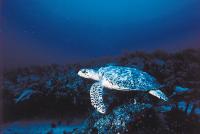 Among sea turtles, the hawksbill turtle, Eretmochelys imbricata, is
the sea turtle species most restricted to tropical waters throughout
its global range. The hawksbill feeds primarily on a diet of sponges,
on which few other vertebrates feed because of their toxic composition
and skeleton of needle-like glass spicules. Hawksbills are important
predators in coral reef habitats, but have been greatly reduced in
numbers as a result of the international trade in tortoiseshell ---
the very beautiful material produced from the scutes that cover the
shell of the hawksbill.
Among sea turtles, the hawksbill turtle, Eretmochelys imbricata, is
the sea turtle species most restricted to tropical waters throughout
its global range. The hawksbill feeds primarily on a diet of sponges,
on which few other vertebrates feed because of their toxic composition
and skeleton of needle-like glass spicules. Hawksbills are important
predators in coral reef habitats, but have been greatly reduced in
numbers as a result of the international trade in tortoiseshell ---
the very beautiful material produced from the scutes that cover the
shell of the hawksbill.
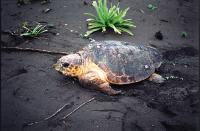 The beaches of the southeastern United States host the largest nesting
population of loggerhead turtles, Caretta caretta, in the Atlantic, if
not in the world. Loggerheads feed on a variety of bottom-dwelling
invertebrates such as crabs, snails, conchs and shrimp. Another
circumglobal species, loggerheads are widely distributed in temperate
and tropical waters.
The beaches of the southeastern United States host the largest nesting
population of loggerhead turtles, Caretta caretta, in the Atlantic, if
not in the world. Loggerheads feed on a variety of bottom-dwelling
invertebrates such as crabs, snails, conchs and shrimp. Another
circumglobal species, loggerheads are widely distributed in temperate
and tropical waters.
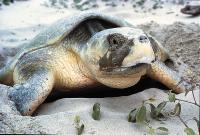 The Kemp's ridley, Lepidochelys kempi, and the olive ridley,
Lepidochelys olivacea, are the only two species of sea turtles that
are placed in the same genus. Similar in appearance, these two species
are the smallest of the sea turtles --- adult body mass averages 90
pounds. Both species have a unique reproductive strategy in which
nearly all reproductive females come ashore simultaneously to nest in
what are termed arribadas --- or arrivals. The Kemp's ridley is the
most endangered species of sea turtle. A film made in 1947 captured
more than 40,000 female Kemp's ridleys in a spectacular arribada at
its only nesting beach at Rancho Nuevo, Mexico. Today, only a few
hundred Kemp's ridleys come ashore to nest. The Kemp's ridley is
restricted in distribution to the Gulf of Mexico and the east coast of
the United States. The olive ridley is widespread in the Pacific and
has smaller populations in the Atlantic.
The Kemp's ridley, Lepidochelys kempi, and the olive ridley,
Lepidochelys olivacea, are the only two species of sea turtles that
are placed in the same genus. Similar in appearance, these two species
are the smallest of the sea turtles --- adult body mass averages 90
pounds. Both species have a unique reproductive strategy in which
nearly all reproductive females come ashore simultaneously to nest in
what are termed arribadas --- or arrivals. The Kemp's ridley is the
most endangered species of sea turtle. A film made in 1947 captured
more than 40,000 female Kemp's ridleys in a spectacular arribada at
its only nesting beach at Rancho Nuevo, Mexico. Today, only a few
hundred Kemp's ridleys come ashore to nest. The Kemp's ridley is
restricted in distribution to the Gulf of Mexico and the east coast of
the United States. The olive ridley is widespread in the Pacific and
has smaller populations in the Atlantic.
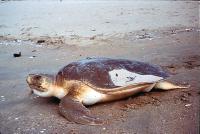 The flatback turtle, Natator depressus, is restricted in distribution
to the Australian continental shelf. The flatback is unusual in that
it is the only sea turtle species in which the post-hatchlings do not
spend their first years living at the surface of the open ocean. The
limited distribution of this species may well result from the lack of
a pelagic stage, which in other species is an important dispersal
mechanism.
The flatback turtle, Natator depressus, is restricted in distribution
to the Australian continental shelf. The flatback is unusual in that
it is the only sea turtle species in which the post-hatchlings do not
spend their first years living at the surface of the open ocean. The
limited distribution of this species may well result from the lack of
a pelagic stage, which in other species is an important dispersal
mechanism.
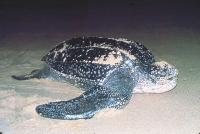 The leatherback turtle, Dermochelys coriacea, is the largest and most
distinctive of the sea turtles. Instead of a hard shell, its body is
encased in a thick leathery shell. Adult leatherbacks can attain a
body mass of 1,000 pounds. Leatherbacks spend most of their lives in
the open ocean, feeding primarily on jellyfish. They are well adapted
to foraging in cold northern waters where jellyfish
abound. Leatherbacks return to tropical waters only to reproduce.
The leatherback turtle, Dermochelys coriacea, is the largest and most
distinctive of the sea turtles. Instead of a hard shell, its body is
encased in a thick leathery shell. Adult leatherbacks can attain a
body mass of 1,000 pounds. Leatherbacks spend most of their lives in
the open ocean, feeding primarily on jellyfish. They are well adapted
to foraging in cold northern waters where jellyfish
abound. Leatherbacks return to tropical waters only to reproduce.

